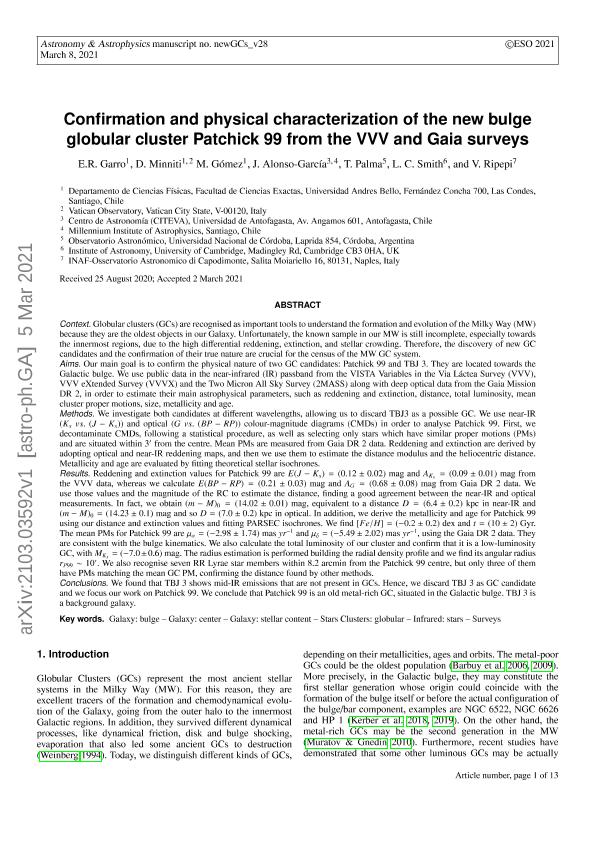Mostrar el registro sencillo del ítem
dc.contributor.author
Garro, E. R.
dc.contributor.author
Minniti, D.
dc.contributor.author
Gómez, M.
dc.contributor.author
García Alonso, J.
dc.contributor.author
Palma, Tali

dc.contributor.author
Smith, L.C.
dc.contributor.author
Ripepi, V.
dc.date.available
2021-08-12T17:43:00Z
dc.date.issued
2021-05
dc.identifier.citation
Garro, E. R.; Minniti, D.; Gómez, M.; García Alonso, J.; Palma, Tali; et al.; Confirmation and physical characterization of the new bulge globular cluster Patchick 99 from the VVV and Gaia surveys; EDP Sciences; Astronomy and Astrophysics; 649; 5-2021; 1-13
dc.identifier.issn
0004-6361
dc.identifier.uri
http://hdl.handle.net/11336/138217
dc.description.abstract
Context. Globular clusters (GCs) are recognised as important tools to understand the formation and evolution of the Milky Way (MW) because they are the oldest objects in our Galaxy. Unfortunately, the known sample in our MW is still incomplete, especially towards the innermost regions, due to the high differential reddening, extinction, and stellar crowding. Therefore, the discovery of new GC candidates and the confirmation of their true nature are crucial for the census of the MW GC system. Aims. Our main goal is to confirm the physical nature of two GC candidates: Patchick 99 and TBJ 3. They are located towards the Galactic bulge. We use public data in the near-infrared (IR) passband from the VISTA Variables in the Via Láctea Survey (VVV), VVV eXtended Survey (VVVX) and the Two Micron All Sky Survey (2MASS) along with deep optical data from the Gaia Mission DR 2, in order to estimate their main astrophysical parameters, such as reddening and extinction, distance, total luminosity, mean cluster proper motions, size, metallicity and age. Methods. We investigate both candidates at different wavelengths, allowing us to discard TBJ3 as a possible GC. We use near-IR (Ks vs. (J − Ks)) and optical (G vs. (BP − RP)) colour-magnitude diagrams (CMDs) in order to analyse Patchick 99. First, we decontaminate CMDs, following a statistical procedure, as well as selecting only stars which have similar proper motions (PMs) and are situated within 30 from the centre. Mean PMs are measured from Gaia DR 2 data. Reddening and extinction are derived by adopting optical and near-IR reddening maps, and then we use them to estimate the distance modulus and the heliocentric distance. Metallicity and age are evaluated by fitting theoretical stellar isochrones. Results. Reddening and extinction values for Patchick 99 are E(J − Ks) = (0.12 ± 0.02) mag and AKs = (0.09 ± 0.01) mag from the VVV data, whereas we calculate E(BP − RP) = (0.21 ± 0.03) mag and AG = (0.68 ± 0.08) mag from Gaia DR 2 data. We use those values and the magnitude of the RC to estimate the distance, finding a good agreement between the near-IR and optical measurements. In fact, we obtain (m − M)0 = (14.02 ± 0.01) mag, equivalent to a distance D = (6.4 ± 0.2) kpc in near-IR and (m − M)0 = (14.23 ± 0.1) mag and so D = (7.0 ± 0.2) kpc in optical. In addition, we derive the metallicity and age for Patchick 99 using our distance and extinction values and fitting PARSEC isochrones. We find [Fe/H] = (−0.2 ± 0.2) dex and t = (10 ± 2) Gyr. The mean PMs for Patchick 99 are µα = (−2.98 ± 1.74) mas yr−1 and µδ = (−5.49 ± 2.02) mas yr−1 , using the Gaia DR 2 data. They are consistent with the bulge kinematics. We also calculate the total luminosity of our cluster and confirm that it is a low-luminosity GC, with MKs = (−7.0±0.6) mag. The radius estimation is performed building the radial density profile and we find its angular radius rP99 ∼ 100 . We also recognise seven RR Lyrae star members within 8.2 arcmin from the Patchick 99 centre, but only three of them have PMs matching the mean GC PM, confirming the distance found by other methods. Conclusions. We found that TBJ 3 shows mid-IR emissions that are not present in GCs. Hence, we discard TBJ 3 as GC candidate and we focus our work on Patchick 99. We conclude that Patchick 99 is an old metal-rich GC, situated in the Galactic bulge. TBJ 3 is a background galaxy.
dc.format
application/pdf
dc.language.iso
eng
dc.publisher
EDP Sciences

dc.rights
info:eu-repo/semantics/openAccess
dc.rights.uri
https://creativecommons.org/licenses/by/2.5/ar/
dc.subject
GALAXY: BULGE
dc.subject
GALAXY: CENTER
dc.subject
GALAXY: STELLAR CONTENT
dc.subject
GLOBULAR CLUSTERS: GENERAL
dc.subject
INFRARED: STARS
dc.subject
SURVEYS
dc.subject.classification
Astronomía

dc.subject.classification
Ciencias Físicas

dc.subject.classification
CIENCIAS NATURALES Y EXACTAS

dc.title
Confirmation and physical characterization of the new bulge globular cluster Patchick 99 from the VVV and Gaia surveys
dc.type
info:eu-repo/semantics/article
dc.type
info:ar-repo/semantics/artículo
dc.type
info:eu-repo/semantics/publishedVersion
dc.date.updated
2021-07-30T18:06:25Z
dc.identifier.eissn
1432-0746
dc.journal.volume
649
dc.journal.pagination
1-13
dc.journal.pais
Francia

dc.journal.ciudad
Paris
dc.description.fil
Fil: Garro, E. R.. Universidad Andrés Bello; Chile
dc.description.fil
Fil: Minniti, D.. Universidad Andrés Bello; Chile. Vatican City State. Vatican Observatory; Italia
dc.description.fil
Fil: Gómez, M.. Universidad Andrés Bello; Chile
dc.description.fil
Fil: García Alonso, J.. Universidad de Antofagasta. Centro de Astronomía; Chile. Millennium Institute of Astrophysics; Chile
dc.description.fil
Fil: Palma, Tali. Universidad Nacional de Córdoba. Observatorio Astronómico de Córdoba; Argentina. Consejo Nacional de Investigaciones Científicas y Técnicas. Centro Científico Tecnológico Conicet - Córdoba; Argentina
dc.description.fil
Fil: Smith, L.C.. University of Cambridge; Reino Unido
dc.description.fil
Fil: Ripepi, V.. INAF - Osservatorio Astronomico di Capodimonte; Italia
dc.journal.title
Astronomy and Astrophysics

dc.relation.alternativeid
info:eu-repo/semantics/altIdentifier/doi/http://dx.doi.org/10.1051/0004-6361/202039255
dc.relation.alternativeid
info:eu-repo/semantics/altIdentifier/url/https://www.aanda.org/articles/aa/abs/2021/05/aa39255-20/aa39255-20.html
dc.relation.alternativeid
info:eu-repo/semantics/altIdentifier/url/https://arxiv.org/abs/2103.03592
Archivos asociados
